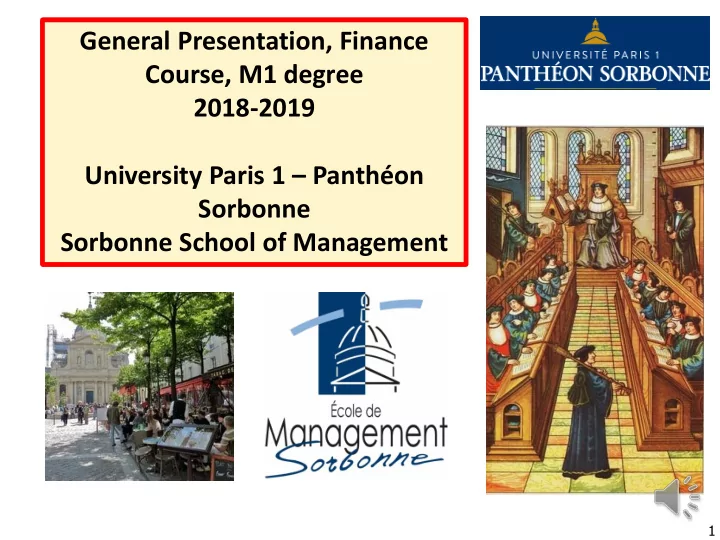

General Presentation, Finance Course, M1 degree 2018-2019 University Paris 1 – Panthéon Sorbonne Sorbonne School of Management 1
◼ Lecturer Jean-Paul Laurent ◼ Professor of Finance, University Paris 1 Panthéon- Sorbonne ◼ Also teaching in the « Finance Magisterium » and the master (M2 degree) « financial markets and risk management » ◼ Research topics within the business department research lab (PRISM – Sorbonne) and the Financial Regulation Lab (Labex ReFi) sponsored by French National Research Agency ◼ Credit and market risks under Basel Committee banking regulations ◼ Implementation of risk measures, modelling of default dependencies ◼ Counterparty credit risk associated with shifts in derivatives markets ◼ Central Counterparties, initial margins 2
◼ M1 degree Finance course ◼ A first step into the world of finance before moving towards different M2 degrees within Sorbonne School of Management ◼ About the lectures ◼ Practically oriented with a focus on basic financial modelling techniques ◼ Intended to provide the fundamental ideas and concepts of modern finance ◼ Risk diversification, risk and return, market efficiency revisited, cost of capital, funding investments, … 3
◼ About the lectures (cont.) ◼ Professionalism : getting used to the toolbox routenely used within corporates and the financial sector (banks, insurance companies, investment funds) 4
Guiding thread: Investments! ◼ From the standpoint of external (to the firm) investors ◼ Stockholders banca, exchange counter ◼ Should buy shares issued by a firm? ◼ What about « expected » returns ◼ Financial analysts and « fundamental value » ◼ Building up portfolios of assets ◼ Risk diversification ◼ Trade-off between risk and return ◼ From the firm’s perspective ◼ CEOs, CFOs ◼ Investments’ choices within the firm ◼ Cost of capital, WACC ◼ Mergers and acquisitions 5
Programme content, part 1: financial markets and investments ◼ Up to 26 October: sessions 1 to 6 ◼ Returns, risk and diversification (1) ◼ Portfolio choice and the efficient frontier (2) ◼ The price of risk and the Capital Asset Pricing Model (CAPM) (3) ◼ The CAPM for practioners: implementation issues: risk-free rate, estimation of betas, risk premia, (4) ◼ Markets’ efficiency, hand -on exercises (5) ◼ Discounting cash-flows: which discount rate? (6) 6
Programme content, part 2: Corporate finance ◼ From 10 November (six + one sessions) ◼ Modigliani- Miller and firm’s liabilities, leveraging the firm, tax benefits of debt, adjusted present value, hand-on exercises ◼ Weighted Average Cost of Capital (WACC), properlyh connecting discount rates and cash-flows, hand-on exercises ◼ Agency costs, trade-off theory of capital structure ◼ Brief introduction to options’ theory, asset substitution and moral hazard issues ◼ The pecking order approach to financing investments 7
Organisation pratique ◼ Most useful prerequisites ◼ Financial Markets and Institutions ◼ Frederic S. Mishkin, Stanley Eakins, Pearson, eight edition, Pearson ◼ Financial Management course, lecture notes ◼ Caroline Emonet Fournier ◼ Statitics and Probability ◼ Expectation, variance, standard deviation, linear correlation coefficient ◼ Least squares, regression analysis ◼ Introduction to Econometrics , Christopher Dougherty, fith edition, 2016, Oxford University Press ◼ Standard financial mathematics ◼ Rates, discouting 8
Course website, presentation slides Link to course website 9
Learning material ◼ Supplementary reference textbook ◼ Corporate Finance d, Jonathan Berk and Peter deMarzo, fourth edition, 2017; Pearson 10
General outline ◼ Lectures based on mainstream approach to finance ◼ Plus insights on best practices ◼ And new lines of research (behavorial finance) ◼ Connected to up-to-date issues (banking regulations) ◼ Standard structure of a Friday’s session ◼ Usually three phases (subsessions) ◼ With dedicated topic and presentation slides ◼ Whenever useful, training and exercises ◼ Smooth mid-session break 11
Asssessment ◼ Written end of term examination ◼ Based on lectures ◼ Examination exercises, exam questions, quiz ◼ Past exams available on course website ◼ End of term examination ◼ Test-time: 1h30 at the Sorbonne or connecte test centers ◼ Scheduled time: January 2019 (TBC) 12
Tutorials ◼ Teaching staff ◼ Ongoing PhD in Finance and Finance professionals ◼ Patricia Dos Santos Mustapha Hjirt, Dorian Pottier, Sarah Schneider, Georgy Shornin, Idriss Tchapda ◼ Eleven sessions starting the week of the 24th of September (or the week after) ◼ Convert theory to practice ◼ Master financial techniques ◼ Brief reminder of concepts, ◼ Interactive exercices to be prepared ahead of tutorials ◼ Bonus for ongoing work achievement ◼ Two interim examinations 13
Tutors (Finance Course, M1 degree) Patrica Dos Santos Idriss Tchapda Mustapha Hjirt 14
Tutors (Finance Course, M1 degree) Georgy Shornin Dorian Pottier 15
Tutorial classes: eleven sessions ◼ Financial Markets and Investments ◼ Theme 0: Basic concepts of probability ◼ Theme 1: Return and risk diversification (S1) ◼ Theme 2: Capital Market Line (S2) ◼ Theme 3: Betas, Security Market Line, security characteristic line (S3) ◼ Thème 4: Review of selected topics, supplementary exercises (S4 & S5) ◼ Interim exam (S5) ◼ Investments and the financing of the firm ◼ Theme 5: Investment decision, NPV, discount rate (S6) ◼ Theme 6: Cost of capital and financial leverage (S7) ◼ Theme 7: Cost of capital and financial leverage (S8) ◼ Thème 8: Review of selected topics, supplementary exercises (S9) ◼ Interim exam 2 (S10) ◼ A brief on financial options ◼ Theme 9: call and put payoffs, two state pricing (S11) 16
Recommend
More recommend